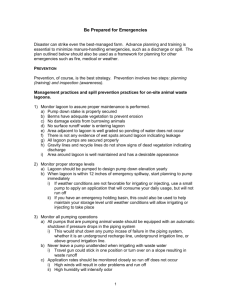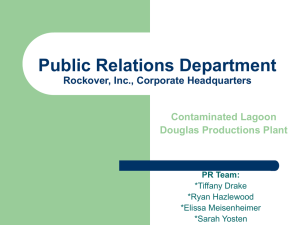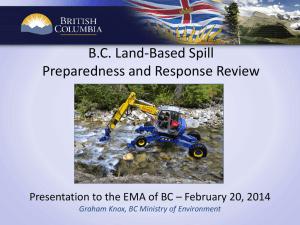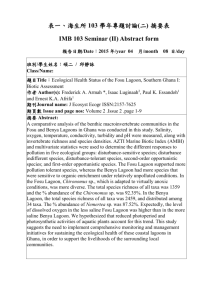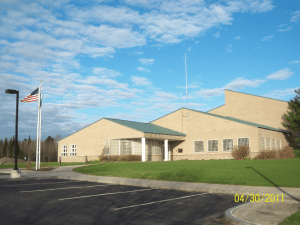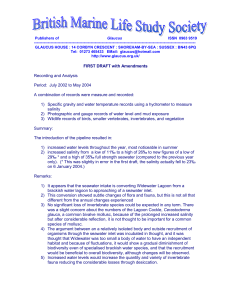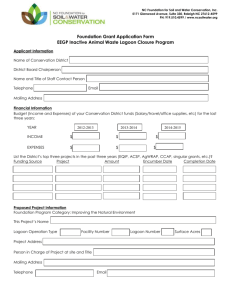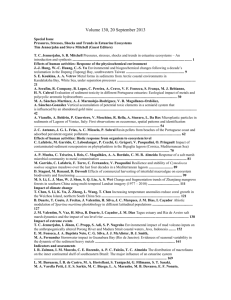Emergency Action Plan 2 - NC Division of Pollution Prevention and
advertisement
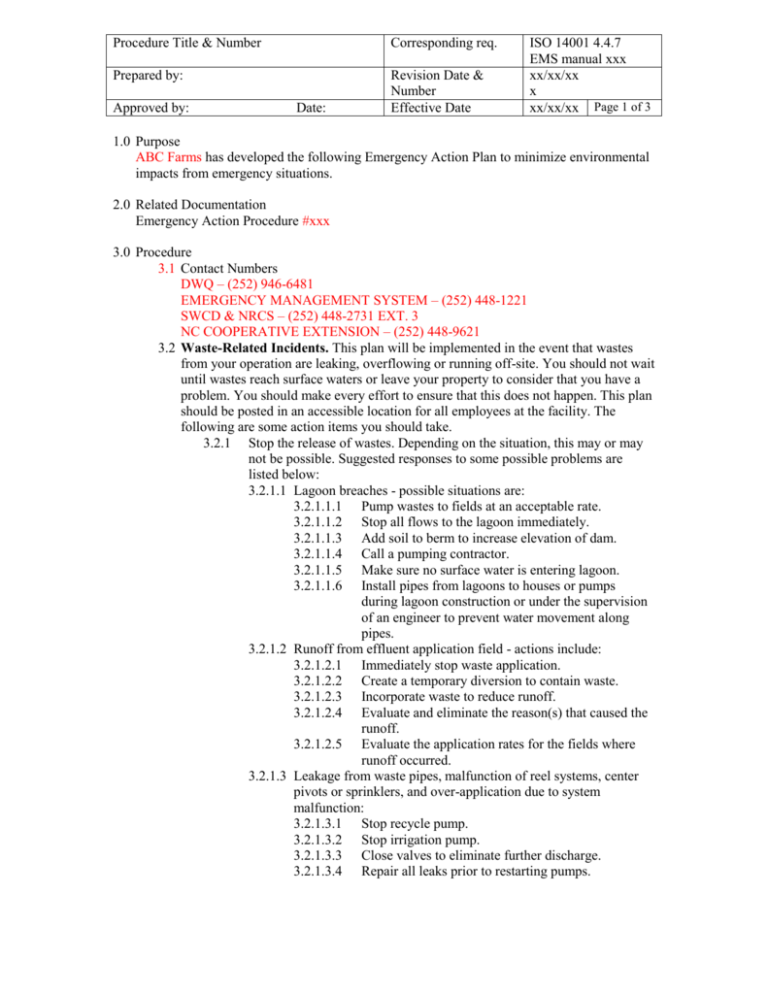
Procedure Title & Number Corresponding req. Prepared by: Revision Date & Number Effective Date Approved by: Date: ISO 14001 4.4.7 EMS manual xxx xx/xx/xx x xx/xx/xx Page 1 of 3 1.0 Purpose ABC Farms has developed the following Emergency Action Plan to minimize environmental impacts from emergency situations. 2.0 Related Documentation Emergency Action Procedure #xxx 3.0 Procedure 3.1 Contact Numbers DWQ – (252) 946-6481 EMERGENCY MANAGEMENT SYSTEM – (252) 448-1221 SWCD & NRCS – (252) 448-2731 EXT. 3 NC COOPERATIVE EXTENSION – (252) 448-9621 3.2 Waste-Related Incidents. This plan will be implemented in the event that wastes from your operation are leaking, overflowing or running off-site. You should not wait until wastes reach surface waters or leave your property to consider that you have a problem. You should make every effort to ensure that this does not happen. This plan should be posted in an accessible location for all employees at the facility. The following are some action items you should take. 3.2.1 Stop the release of wastes. Depending on the situation, this may or may not be possible. Suggested responses to some possible problems are listed below: 3.2.1.1 Lagoon breaches - possible situations are: 3.2.1.1.1 Pump wastes to fields at an acceptable rate. 3.2.1.1.2 Stop all flows to the lagoon immediately. 3.2.1.1.3 Add soil to berm to increase elevation of dam. 3.2.1.1.4 Call a pumping contractor. 3.2.1.1.5 Make sure no surface water is entering lagoon. 3.2.1.1.6 Install pipes from lagoons to houses or pumps during lagoon construction or under the supervision of an engineer to prevent water movement along pipes. 3.2.1.2 Runoff from effluent application field - actions include: 3.2.1.2.1 Immediately stop waste application. 3.2.1.2.2 Create a temporary diversion to contain waste. 3.2.1.2.3 Incorporate waste to reduce runoff. 3.2.1.2.4 Evaluate and eliminate the reason(s) that caused the runoff. 3.2.1.2.5 Evaluate the application rates for the fields where runoff occurred. 3.2.1.3 Leakage from waste pipes, malfunction of reel systems, center pivots or sprinklers, and over-application due to system malfunction: 3.2.1.3.1 Stop recycle pump. 3.2.1.3.2 Stop irrigation pump. 3.2.1.3.3 Close valves to eliminate further discharge. 3.2.1.3.4 Repair all leaks prior to restarting pumps. Procedure Title & Number 3.2.2 3.2.3 3.2.4 3.2.5 Revision Date & Number Effective Date xx/xx/xx x xx/xx/xx Page 2 of 3 3.2.1.4 Leakage from flush systems, houses, solid separators - possible corrective actions include: 3.2.1.4.1 Stop recycle pump. 3.2.1.4.2 Stop irrigation pump. 3.2.1.4.3 Avoid siphoning by installing pipes correctly during construction by correct pipe heights. 3.2.1.4.4 Repair all leaks prior to waste handling or irrigation system activation. 3.2.1.5 Leakage from base or sidewalls of lagoons. Often this is seepage as opposed to flowing leaks - possible corrective actions include: 3.2.1.5.1 Dig a small sump or ditch away from the embankment to catch all seepage, put in a submersible pump, and pump back to the lagoon. 3.2.1.5.2 If holes are caused by burrowing animals, trap or remove animals, fill holes and compact with a claytype soil. 3.2.1.5.3 Have a professional evaluate the condition of the sidewalls and lagoon bottom as soon as possible. Assess the extent of the spill and note any obvious damages. 3.2.2.1 Did the waste reach any surface waters? 3.2.2.2 Approximately how much was released and for what duration? 3.2.2.3 Any damage noted, such as employee injury, fish kills or property damage. 3.2.2.4 Did the spill leave the property? 3.2.2.5 Does the spill have the potential to reach surface waters? If yes, how many gallons? 3.2.2.6 Could a future rain event cause the spill to reach surface waters? If so, are there options to prevent it such as soil incorporation or putting a temporary berm around the spill area? Are there water control structures in place that could hold the spilled effluent until it can be safely recovered? 3.2.2.7 Are potable water wells in danger either on or off the property? Contact the appropriate agencies. 3.2.3.1 During normal business hours, call your DWQ (Division of Water Quality) regional office. Phone . After hours, call . Your phone call should include: your name; the facility number; your phone number and the details from 2 above; the farm’s exact location; the location or direction of movement of the spill; weather and wind conditions; the corrective measures that have been undertaken; and the seriousness of the situation. 3.2.3.2 If the spill leaves the property or enters surface waters, call your local EMS phone number, , and local NRCS office for advice/technical assistance at , extension . If none of the above works, call 911 or the sheriff’s department and explain your problem to them and ask that person to contact the proper agencies for you. Contact the contractor of your choice to begin repair of problems to minimize off-site damage. 3.2.5.1 Contractors name: . 3.2.5.2 Contractors address: . Procedure Title & Number Revision Date & Number Effective Date xx/xx/xx x xx/xx/xx Page 3 of 3 3.2.5.3 Contractors phone: Contact the technical specialist who certified the lagoon (NRCS, consulting engineer, etc.) 3.2.6.1 Name: . 3.2.6.2 Phone: . 3.2.7 Implement procedures as advised by DWQ and technical assistance agencies to rectify the damage, repair the system, and reassess the waste management plan to keep problems from happening again. 3.3 Catastrophic Death Losses In the event of catastrophic death losses of farm animals call one the following to activate the County Animal Response Team (C.A.R.T) plan. 3.3.1 County Cooperative Extension Director/County C.A.R.T. Coordinator at 3.3.2 County Emergency Coordinator . 3.3.3 County Manager . 3.2.6 4.0 Revision History Revision Date & # Revision
